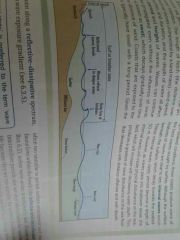![]()
![]()
![]()
Use LEFT and RIGHT arrow keys to navigate between flashcards;
Use UP and DOWN arrow keys to flip the card;
H to show hint;
A reads text to speech;
28 Cards in this Set
- Front
- Back
|
Fetch |
The distance over which air moves unimpeded by a land mass |
|
|
What characterises dissipative coasts? |
Gently sloping offshore substratum Fine sediments Rich fauna Low energy |
|
|
What characterises reflective coasts? |
Coarse sediments Large waves Steep slopes Impoverished fauna High energy |
|
|
Wave propagation along the coast |

|
|
|
What determines upper distributional limits on rocky shore zonation? |
Physiological tolerance to physical factors (therml stress, dessication) |
|
|
What determines lower distributional limits on rocky shore zonation? |
Physical tolerance, bio-interactions, growyh form and life span. |
|
|
Critical tide level theory |
Tides are responsiblenfor zonayion seen on rocky shores. |
|
|
Tides |
Rhytmic rise and fall of sea levels. |
|
|
Diurnal tides |
One high and one low per day |
|
|
Semi-diurnal |
Rise and fall twice a day (successive highs and lows approx equal in heihht) |
|
|
Mixed tides |
Twice a day, unequal higs and lows |
|
|
Features that modify tides |
Basin morphology Mid ocean islands and ridges Atolls High latitude, vs low latitude coasts |
|
|
Factors that canaffect or influence tides |
Meterological events Hurricanes, typhoons, storms Geological events Submarine earthquake, sudden massive shifts on the sea floor |
|
|
Photoperiodism |
The response of an organism to seasonal changes in day length. |
|
|
Photomorphogenetic |
Process by which plants grow and develop in response to light signals. |
|
|
Chlorophyta chlorophyll pigments |
Chl a chl b |
|
|
Euglenophyta chlorophyll pigments |
Chla Chl b |
|
|
Heterokontophyta |
Chl a Chl c1 Chl c2 Accessory pigments (diatoxanthin, fucoxanthin) |
|
|
Phaeoohyta |
Chla Chlc1 Chlc2 Accessory pigments |
|
|
Pyrrophyta |
Chla Chlc Peridinin phycobiliproteins(phycocyanins &phycoerythrin) |
|
|
Cyanophyta |
Chla Phycobiliproteins(phycocyanins & phycoerythrin ) |
|
|
Cryptophyta |
Chla, Chl c, phycobiliproteins and accessory pigments |
|
|
Circadian rythmns |
24 hr cycle metabolic or behavioural activiy |
|
|
How does light influence functions of marine plants and algae |
Metabolic activiy Reproduction Distribution with depth Circadian rythmns |
|
|
How does light influence marine plants and algae structure? |
Changes in size Production of flagells Buoyancy regulation |
|
|
Photosynthetically Active region |
Electromagnetic region where chlorophylls and other light harvesting pigments absorb light. Ranges from 380nm-700nm Some algae can absorb as low as 300nm |
|
|
Photon flux density |
A measure of the number of photons per second per unit area |
|
|
Maximal light energy absorption wavelengths Of pigments |
Chlorophyll a - 425nm and 650 nm Chlorophyll b - 490nm and 620nm Phycocyanin - 620 Phycoerythrin - 500-550 |

